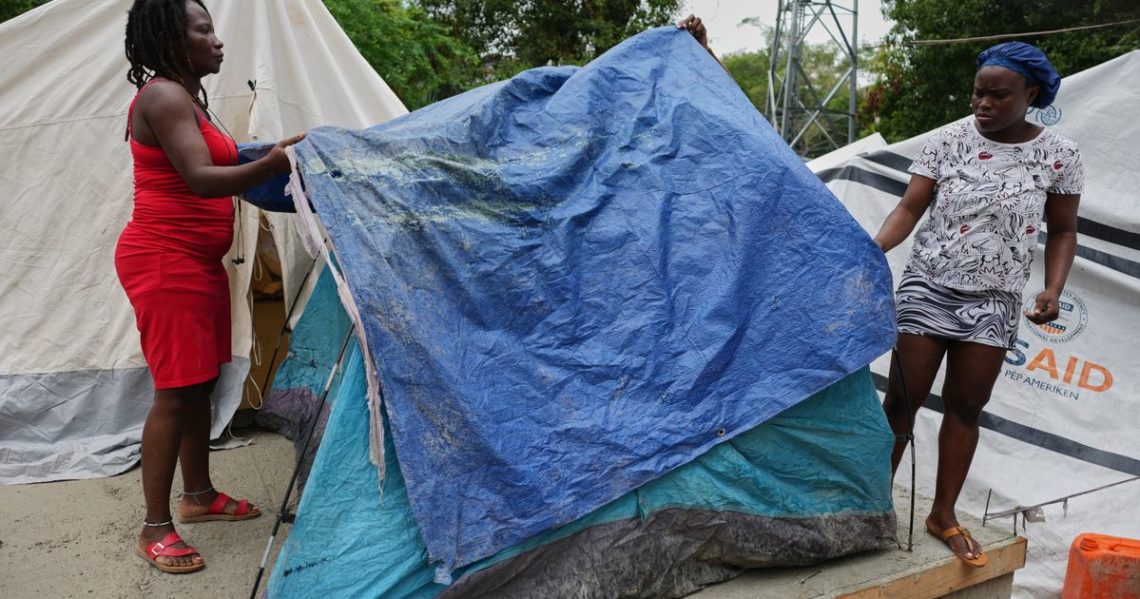SAN JUAN, Puerto Rico (AP) — Tropical Storm Melissa was stationary in the central Caribbean early Friday, with forecasters warning it could soon strengthen and brush past Jamaica as a powerful hurricane while unleashing potentially “catastrophic” flash flooding and landslides in southern Haiti.
The erratic storm was expected to drop copious rain on Jamaica and the southern regions of Haiti and the Dominican Republic through the weekend.
“The rainfall is a huge risk with the storm,” said Michael Brennan, director of the U.S. National Hurricane Center in Miami. “Rainfall has historically been the biggest cause of loss of life of tropical storms and hurricanes in the Caribbean.”
Early Friday, the storm was stationary about 165 miles (260 kilometers) southeast of Kingston, Jamaica, and about 275 miles (445 kilometers) southwest of Port-au-Prince, Haiti. It had maximum sustained winds of 45 mph (75 kph), the U.S. center said. It was expected to begin to drift northeast or north later in the day before turning west over the weekend.
A hurricane watch and a tropical storm warning were in effect for Jamaica and the southwestern peninsula of Haiti.
Melissa was expected to slowly begin moving closer to Jamaica over the weekend. It was expected to strengthen into a hurricane by Saturday and become a major hurricane by the end of the weekend, possibly reaching Category 4 status by Tuesday.
Forecasters said Jamaica’s eastern region could get up to 14 inches (36 centimeters) of rain that could lead to flooding and landslides because the ground is already saturated from recent heavy rains unrelated to the storm.
Schools, health centers and government offices closed across Jamaica on Thursday, with authorities warning that all airports would close within 24 hours if a hurricane warning is issued.
“The situation is indeed serious,” said Matthew Samuda, Jamaica’s minister of economic growth and job creation, as he warned people not to be fooled by the storm’s current pace and strength. “Be very attentive, because it can change in a moment’s notice.”
Up to 14 inches (36 centimeters) of rain also was forecast for southern Haiti and the southern Dominican Republic, with higher amounts possible through Sunday.
Melissa was blamed for one death in southern Haiti, and five other people in the country’s central region were injured in flooding, authorities said. The U.N. announced Thursday that it was preparing more than 100 emergency shelters in Haiti’s southern region.
The storm also knocked out dozens of water supply systems in the neighboring Dominican Republic, affecting more than half a million customers. It also downed trees and traffic lights and unleashed a couple of small landslides.
All public schools across the Dominican Republic would close Friday, while government offices in 12 provinces under alert would do the same, officials said.
“This is an event that we should be following minute by minute,” said Juan Manuel Méndez García, emergency operations director in the Dominican Republic. He noted that evacuations in areas under alert were mandatory.
Melissa is the 13th named storm of the Atlantic hurricane season, and the first named storm to form in the Caribbean this year.
The U.S. National Oceanic and Atmospheric Administration had predicted an above-normal season with 13 to 18 named storms. Of those, five to nine were forecast to become hurricanes, including two to five major hurricanes, which pack winds of 111 mph (178 kph) or greater.
The Atlantic hurricane season runs from June 1 to Nov. 30.
The post Tropical Storm Melissa stationary in the Caribbean as forecasters warn it will quickly intensify appeared first on Associated Press.




